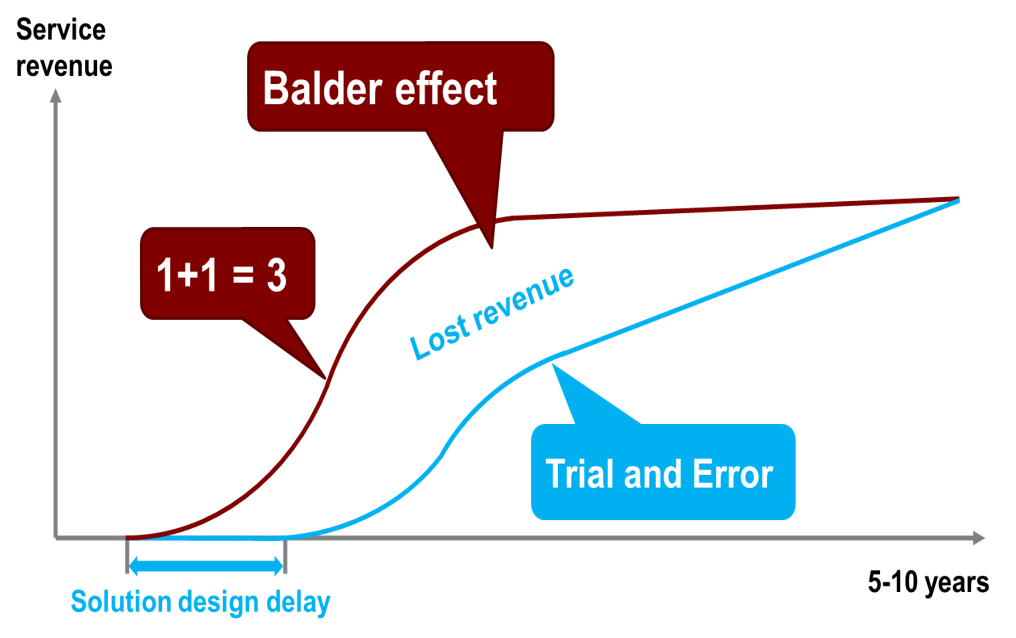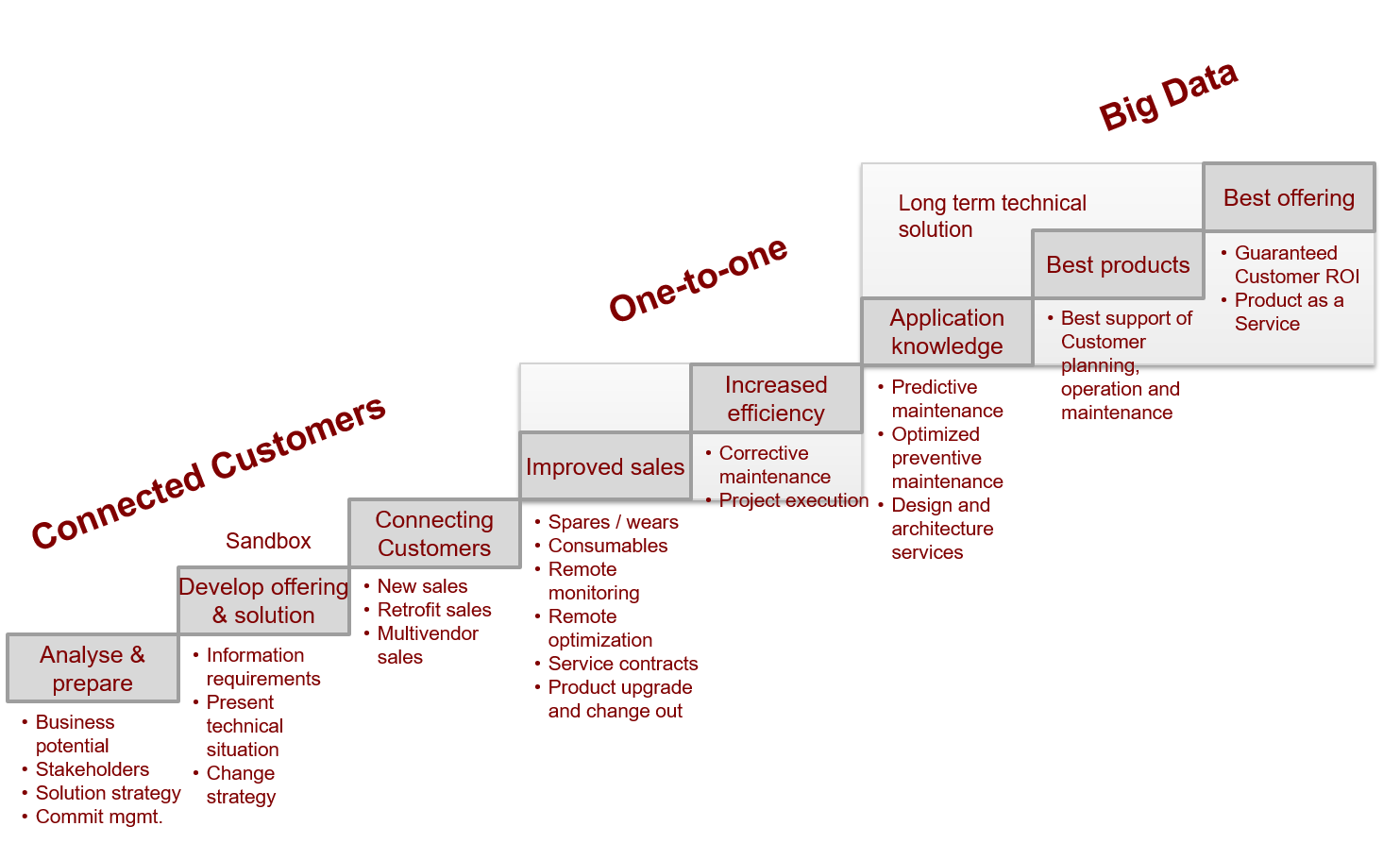"We support Customers avoiding risks when improving" |
Real life Remote Services quotes:
“How should we price the remote maintenance so it's not cannibalizing on our on-site visit service?”
“How should the help desks in every country be paid?”
“How should we staff the Remote Centres?”
“What is the best IT solution for our remote qualification?”
“Who are the business owners of Remote Services? Who tries to increase our earnings in this area?”
“What are the steps towards our Remote Services vision?”
“How to implement standardized Remote Services when every local organisation is different?”
Other focused areas?
Other messages:
From product to solution provider
Proactive service delivery / Operational excellence 2.0 (a 15 page paper)
The Top 10 Internet of Things risks
Remote Services, an important Internet of Things area
Best practice Companies sell and delivery a full range of remote services maximizing their business growth, Customer satisfaction and use of their limited expertise to provide the services faster and cheaper to more Customers. Whereas most companies just use the connectivity to improve their maintenance delivery.
The reasons for that is that developing and implementing a remote services portfolio is complex (identifying and designing the offerings, avoiding cannibalism of existing on-site services, pricing, value propositions, way of selling, sales support, incentive model, measurements…) and it require organisational changes (remote centres, role descriptions, cost distribution, change mandate …).
You will only do this change in your company one time. Once you have achieved it, the experience is basically useless as you never will do it again. This applies to all companies and as it happens so seldom, very little in-house experience exists. Without experience you have to invent the solution, try it small scale, improve it and try it again in larger scale etc. This “trial and error” takes a lot of time and can be very risky.
Balder Consulting has this experience from:
- 3 different industries where we have developed, implemented, sold and delivered remote service portfolios beginning already in the 80’s. This during our line careers.
- We have assisted Customers to develop and implement remote services in assignments.
- We have interacted with a large number of manufacturing companies, in our knowledge sharing workshops. They are struggling with this opportunity and we have gained a lot of experience of mistakes to avoid from these workshops.
… and we have consolidated our experience into world class models, key success factors and best approach methodologies benefitting our Customers.
 1+1=3. If we marry your expertise of your company and your Customers with our experience, we can achieve significant results faster. You will increase revenues with less investments.
1+1=3. If we marry your expertise of your company and your Customers with our experience, we can achieve significant results faster. You will increase revenues with less investments.
If we are assigned to manage the joint initiative, we are able to guarantee the remote service sales growth and be paid by a fraction of the result.
Contact me to further discuss Your opportunity:
Lennart Neujd, CEO Balder Consulting
Email: lennart.neujd@balderconsulting.com
Mobile:+46-707 894 887
One key parts of the Internet of Things opportunity is Remote Services, which provides great financial impact but also challenging to achieve. How many in Your organisation have previous experience in successfully designing and implementing Remote Services?
Background
Already in the 80’s IT vendors remotely connected Customers’ equipment to faster and better support them with different types of remote services. Security companies monitored a large number of Customers' premises. Telecom vendors remotely maintained Customer equipment. Then the Internet came and today everything should be connected to “the cloud”. Machines, vehicles, people … Internet of Everything.
The Remote Service opportunity
 Today, when almost all intelligent equipment can be connected, when communication solutions are mainstream and when people are mentally prepared for remote solutions the Remote Services opportunity is available for many manufacturing, installation, construction and service companies.
Today, when almost all intelligent equipment can be connected, when communication solutions are mainstream and when people are mentally prepared for remote solutions the Remote Services opportunity is available for many manufacturing, installation, construction and service companies.
New exiting, competitive Company offerings can be provided and internal processes can be dramatically improved when activities are remotely performed by skilled, specialized people. Studies shows that Customers are asking for remote services because they are both cost efficient and faster to perform – they deliver a lot of Customer value and can become a high margin area for the service provider, when priced correctly.
Remote services can be included in the “connecting services”, i.e. the services offered convincing the Customers to connect their equipment and start sharing data in an Internet of Things solution.
Transforming into remotely provided services can also increase the “good usage” of scarce resources. Very often is the availability of specific expertise in certain geographies limited and can form a constraint for both growth and increased Customer satisfaction. Remote services experts can easily be available anywhere and at any time.
Remote Services – first phase of the Internet of Things evolution
 Remote Services can deliver value even if only one Customer is connected. Therefore, the Remote Services can be explored before large volumes of Customers are connected and the IoT solution is moving into the Big Data phase.
Remote Services can deliver value even if only one Customer is connected. Therefore, the Remote Services can be explored before large volumes of Customers are connected and the IoT solution is moving into the Big Data phase.
Types of remote services
There are many different types of remote services. Some of them very people intensive (remote reactive repair, optimization, operation) and some can be much more automated (remote monitoring, remote preventive and predictive analysis). Remote services can be everything from just remotely performed activities to "product as a service" concepts. Every company have their unique opportunity in the Remote services area to improve their competitiveness and efficiency.
It is a rather complicated process to find the best Remote Services road map for a company, to design the remote services, to make the necessary organisational changes and to implement the new services in order to successfully sell and deliver them.
The main Remote Services challenges
Today many companies have decided to enter the world of remote services but they haven’t fully understood the potential challenges:
 Remote service portfolio. What kind of remote services should be developed and how to design each service in detail? What is the scope, the service level, the price model …?
Remote service portfolio. What kind of remote services should be developed and how to design each service in detail? What is the scope, the service level, the price model …?- Pricing of remote service offerings should much more be based on market pricing and Customer value than just cost plus. How should the price level be set to balance on-site services, competitor services, Customer own alternative?
- Operational model. What should be done on local, regional and company level? What is the new delivery process? What kind of new roles are introduced?
- Organisation. How many centralized service centres should you develop? Who are responsible for each centre? How does the blue print of a centre look like? How should you govern regional and companywide centres?
- IT solution and delivery process. What kind of changes needs to be done in the delivery processes and of the service management system supporting it? Is IT applications required to support the delivery workflow?
- Competence. How do you identify and build the right competences / capabilities in the remote services delivery organisations?
- Financing of new centralized structures needs to be sorted out. How should costs be internally allocated without destroying local business incentives?
- Implementation. How to make the remote services sold and delivered in all service units in all markets? What is the change management method and how is the implementation verified?
- Culture and power-shift. How to recruit people to deliver the remote services and how to manage the power-shift that will happen when remote service delivery people rapidly reach competence levels above the field gurus.
- Road map. How should the remote services be developed over time? What is launched first in the market and how do you evolve the area?
- Governance. Who is the owner of the internal and external remote services? How do you explore synergies in the area while avoiding cannibalising on existing services?
Customers, partners and internal organisations need to be investigated to understand what activities that preferably are moved and performed by one or fewer centralized, specialized remote centres.
New strategies need to be developed for where new remote centres should be established, the scope and blueprint of the centres, the governance of the centres … A transition plan where Customer, partner or internal activities are migrated from many places to fewer places needs to be defined.
Products and stakeholders need to be analysed to understand what kind of automated solutions that can dramatically improve the company image and financial contribution.
For many companies these changes could be classified as “once in a life time”. There are limited in-house experience from similar projects and there is therefore a substantial risk that the project is dramatically delayed and the final solution is not optimal, resulting in significant lost revenue and lost efficiency gains.
Why are there so many challenges?
 Many of the companies that have ambitions in the IoT / Remote services areas are technology centric. Their core competence is technical. The organisation (including management) is technically oriented and the remote services challenges are mainly seen from a technical and Customer satisfaction point of view.
Many of the companies that have ambitions in the IoT / Remote services areas are technology centric. Their core competence is technical. The organisation (including management) is technically oriented and the remote services challenges are mainly seen from a technical and Customer satisfaction point of view.
One major fault that many companies are doing is that they do not address Remote Services from a commercial and sales point of view and the result is often that after some years they have a perfectly working technical solution, which is not sold and have a very limited Customer base connected. The services delivered are typically to improve the maintenance delivery with no or little additional revenue.
In other words: “They have invested a lot of money, resources, time and got very little return”.
We advocate and support Customers to address all business aspects. Yes, it is complex but will be very rewarding.
Our Customers are levering on our experience
We have line experience from these kind of transitions and we have supported companies in their development of Remote Services – as an important evolutionary step towards Big Data.
 Our Customers trust that we can support them developing and implementing their Remote Services solutions faster and better. They believe that the fee they pay us is just a fraction of the extra money they will gain when utilizing our knowledge and experience. They are convinced that without previous knowledge and experience they are left with years of “trial & error” approach, which comes with any self-learning.
Our Customers trust that we can support them developing and implementing their Remote Services solutions faster and better. They believe that the fee they pay us is just a fraction of the extra money they will gain when utilizing our knowledge and experience. They are convinced that without previous knowledge and experience they are left with years of “trial & error” approach, which comes with any self-learning.
We have seen many companies, deciding to develop Remote Services on their own without previous experience, being forced to test every step in small scale before driving the change companywide and this stretch the time plan enormously.
If you have ambitions to improve your offering competiveness or internal efficiency with Remote Services, please think about what kind of in-house experience you have in starting up remote services. We have done a number of projects in the area – how many have you done? It is not about intelligence – it’s just about experience. Use our experience and become more successful much faster.
A classic Remote Services Case study
This is a classic example in how a company is developing and implementing Remote Services when not having previous experience. In the end they got there but it took them very long time.
A traditional manufacturing company is successfully selling, installing and maintaining their complex products all over the world. It has been a challenge to provide right level of skills when installing and maintaining products in many geographies and experts have been flown around the world.
10 years ago the company launched a remote services strategy with focus on remote maintenance. The normal setup was that Customers provided first line maintenance (on site) and they were supported by the company 2nd line field service technicians doing site interventions (classic setup).
 3 competence centres (one in Mexico, one in Poland and one in China) were established with a common service management solution. Customer service tickets could be opened in one centre and closed in another and also sent to any local country. The centres were manned with skilled field technicians and a career path was created to ensure job rotation with top of the line skills in the centres.
3 competence centres (one in Mexico, one in Poland and one in China) were established with a common service management solution. Customer service tickets could be opened in one centre and closed in another and also sent to any local country. The centres were manned with skilled field technicians and a career path was created to ensure job rotation with top of the line skills in the centres.
Today, the Company claims that they are utilizing their scare product experts more efficient (effective work have increased from 35 % to close to 70%). The scope of remote services has also been expanded from an initial focus on maintenance to also include both installation support and optimisation services. Installation technicians are supported by the remote centres and the final functionality verification is today formally the responsibility of the remote organisation today.
Initially it was difficult to establish the remote centres because the shift of mandate from the field to the remote organisation but after some years, when the remote organisation got more established, and job rotation was adopted, the resistance changed into a cautious optimism.
Financially it has been a success both in revenue growth, where the remote services have more than tripled, but moreover in margin where the remote services today deliver a margin of 65%.
With this set-up the company is able to serve far more customers by their experts and as the equipment is critical in process manufacturing, the increased speed of service is highly appreciated.
And there is no way back. If the remote service solution should be transferred into the previous on-site solution the company will need to hire and develop close a 200 expert technicians, which is seen by management as almost impossible. In relation the company has 850 field technicians and the remote experts are around 50.
Today they are rather thinking about taking the next step into Customer self service solutions and predictive maintenance to increase the utilization of the technical expert organisation and to increase the value of delivered services further.
The company in this study didn't have a clear view on how their optimal Remote Services solution should be designed and they had to make a number of small scale trails before they finally arrived at the solution of today. Our view is that the Remote Services solution, in this study, could have been be developed in a third of the time.